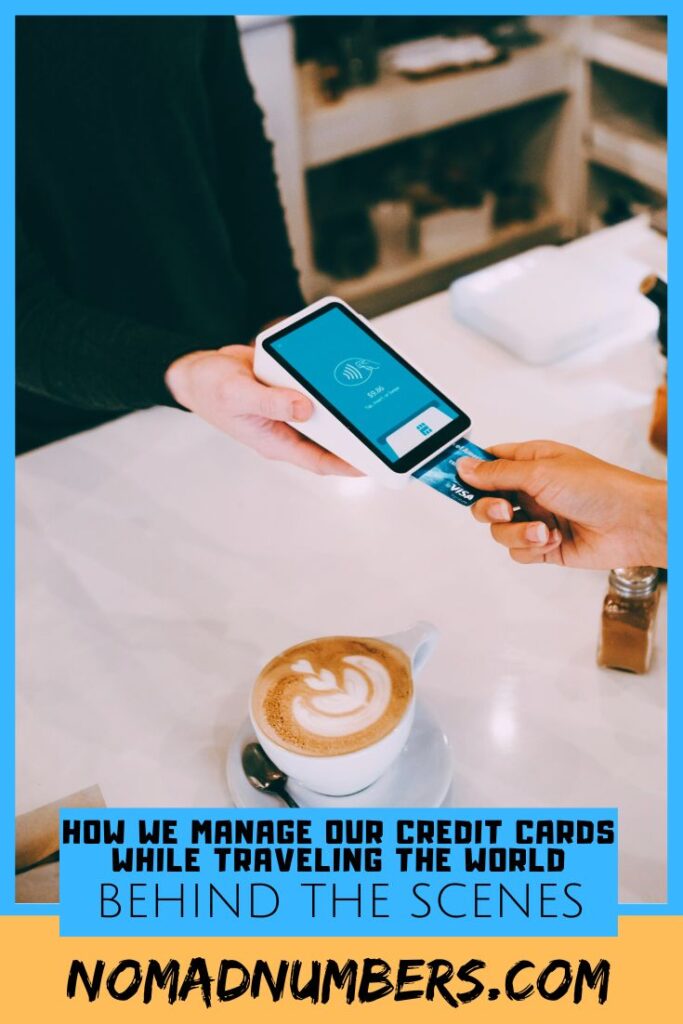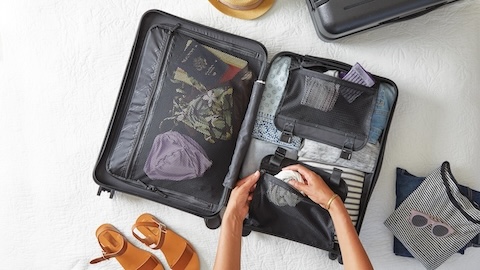In our slow nomadic journey, a big part of our spending goes toward travel cost. Thanks to travel rewwards – a game-changer strategy – we are able to slashed these expenses to under a thousand dollars a year, which is a saving of about $6,000-$10,000 a year!
Dealing with multiple credit cards while constantly moving between countries used to be a real headache though. But, thanks to the availability of services like Traveling Mailbox, coupled with the widespread use and acceptance of platforms like Apple Pay and Google Pay, things have become so much smoother.
In this blog post, we’re excited to share our latest strategies for using credit cards (with travel rewards) while we explore different corners of the globe. We want to walk you through the exact steps we take to make the most of these travel rewards, even when we’re far from our home base. Join us as we unpack how these tools have revolutionized our travel finances and how they can potentially do the same for you.
Understanding Travel Rewards
Travel rewards are perks or benefits offered by certain credit cards or loyalty programs that cater specifically to travelers. These rewards are earned when you make purchases using the credit card and can be redeemed for various travel-related benefits. They often come in the form of:
- Points: Accumulated through spending, these points can be redeemed for flights, hotel stays, car rentals, or other travel-related expenses.
- Miles: Often associated with airline credit cards, miles can be redeemed for flights, upgrades, or other airline-related perks.
- Cash Back: Some travel cards offer cash-back rewards that can be used toward travel expenses or simply deposited into your account.
These rewards can significantly offset the cost of travel, providing benefits such as free flights, discounted hotel stays, airport lounge access, travel insurance, and more. The more you use your card for everyday purchases or specific categories (like dining or travel expenses), the more rewards you accumulate, offering great value to frequent travelers.
Here are our latest travel rewards reports where you can see for yourself how much we saved over the past few years:
- 2019 End of Year Travel Rewards Report
- 2020 End of Year Travel Rewards Report
- 2021 End of Year Travel Rewards Report
Understanding Mailing Scanning
A mail scanning and forwarding service is a system that enables individuals or businesses to manage their postal mail remotely. Here’s how it typically works:
Mail Scanning
- Receiving Mail: The service provides users with a physical mailing address, often in a location of their choice. When mail is sent to this address, the service receives it on behalf of the user.
- Scanning and Digitization: Upon receiving the mail, the service scans the outside of envelopes or packages. Users receive digital images or scans of their incoming mail, accessible via an online platform or through an app.
- Digital Access: Users can view their mail online, seeing the outside of the envelopes and sometimes the content if they request the service to open and scan the mail’s contents.
Mail Forwarding
- Forwarding Options: Users have the ability to request their physical mail be forwarded to an address of their choice. This could be another physical location, such as their current residence, a business address, or even an international destination.
- Frequency and Preferences: Forwarding can be scheduled on a regular basis or triggered manually, based on the user’s preferences.
For individuals seeking credit cards or managing important financial documents while traveling, these services offer a stable and secure way to receive and manage physical mail, ensuring they don’t miss crucial communications or opportunities even while on the move.
Understanding Traveling Mailbox
For more details about Traveling Mailbox,
please read our in-depth review of Traveling Mailbox.
Traveling Mailbox is a mail scanning and forwarding service designed for individuals, travelers, businesses, and digital nomads who need a flexible and secure way to manage their postal mail remotely. It provides users with a physical mailing address, typically in the United States, which they can use for receiving mail and packages.
Here’s how Traveling Mailbox generally works:
Features
- Virtual Mailbox: Users receive a digital copy of their incoming mail. The service scans the outside of the envelopes and packages, allowing users to view their mail online.
- Mail Forwarding: Users can request to have their physical mail forwarded to an address of their choice, whether it’s another physical location or an international destination.
- Mail Management: The service allows users to manage their mail digitally, organizing, archiving, shredding, or recycling mail as needed.
- Security: It often employs robust security measures to protect sensitive information, ensuring the safety and confidentiality of the mail received.
Benefits
- Accessibility: Users can access their mail from anywhere in the world as long as they have an internet connection.
- Convenience: It offers a solution for those who travel frequently or live a nomadic lifestyle, allowing them to stay connected to their postal mail without being physically present.
- Privacy: Protects personal information by reducing the need for a fixed physical address, especially for those who are frequently on the move.
How it Applies to Travel and Credit Cards:
For travelers seeking credit cards while on the go, services like Traveling Mailbox provide a stable mailing address, enabling them to receive credit card applications and physical cards securely. Users can receive, view, and manage credit card-related mail digitally, ensuring they don’t miss out on essential financial documents while traveling.
By using a service like Traveling Mailbox, we maintained control over our postal mail, including credit card applications from anywhere in the world, ensuring we don’t miss out on important opportunities and get our credit card as soon as possible.
Requesting a scan take usually a few hours and from there we can then start using our card anywhere in the world using platform like Apple Pay or Google Pay.
How to setup Apple Pay or Google Pay
Setting up Apple Pay or Google Pay or your phone (or watch) is a convenient way to make payments without the physical card that we started using a few years ago. This has been a game changer.
Here’s a simple guide for both:
Apple Pay
For iPhone:
- Open Wallet: Launch the Wallet app on your iPhone.
- Add a Card: Tap the “+” icon to add a new card.
- Follow Instructions: You can either manually enter your card details or use the camera to capture the card information.
- Verify Card: Your bank might require verification through a code or a phone call.
- Agree to Terms: Agree to the terms and conditions.
For Apple Watch:
- Open Apple Watch App: Go to the “My Watch” tab and select “Wallet & Apple Pay.”
- Add a Card: Follow similar steps as you would on your iPhone.
Google Pay
For Android Phones:
- Download Google Pay: If not pre-installed, download Google Pay from the Google Play Store.
- Open the App: Open Google Pay.
- Add a Payment Method: Tap on “Payment” or “Payment methods” to add your card.
- Enter Card Details: Input your card details manually or capture them with the camera.
- Verification: Verify your card with the bank if required.
Once set up, you can use your phone or wearable device at contactless payment terminals, simply by holding it near the reader and confirming the payment with your fingerprint, Face ID, or passcode.
LinePay as an Alternative in Asia
Although many countries embrace Apple Pay and Google Pay, some regions favor alternative payment methods. In Taiwan, Line Pay enjoys considerable popularity and offers the option to link international credit cards. Here’s a basic guide on how to set it up:
Setting Up Line Pay with a Credit Card:
- Access Line Pay: Open the Line app on your mobile device and navigate to the Line Pay feature.
- Link a Credit Card:
- Tap on the “Wallet” or “Settings” section within Line Pay.
- Look for an option to “Add a Credit Card” or “Add a Payment Method.”
- Select “Credit Card” and then proceed to enter your credit card details.
- Verification: Line Pay might require verification of the card for security purposes. This can include confirming via SMS, email, or a small charge on your credit card that you need to verify.
- Agree to Terms: Follow any prompts or agreements that appear to finalize the setup process.
Using Line Pay with Your Credit Card:
Once your credit card is linked to Line Pay, you can make payments or transactions using Line Pay at supported merchants or within the Line app itself:
- In Stores: Look for merchants or stores that accept Line Pay. At the checkout, inform the cashier that you’ll be paying with Line Pay. Open the Line app, access Line Pay, and scan the merchant’s QR code or use NFC if available. Confirm the payment.
- In the Line App: You can also use Line Pay to buy stickers, games, or other digital content within the Line app itself.
Remember, the specific steps might vary slightly based on the version of the Line app and the region you are in.
Our Bottom Line
As we navigate this digital world, the possibilities for enhancing our travel experiences and managing our money on the move are more exciting than ever. Racking up those sweet travel rewards has never been easier thanks for virtual mailbox like Traveling Mailbox and virtual payment options like Apple Pay or Google Pay that can be easily setup on our devices.
Are you on a mission to squeeze every bit of travel reward goodness while far from home as we do? Perhaps you’ve considered using mail scanning services or counting on a helpful relative to manage your mail while on the move. What about payment services like Apple Pay and Google Pay, liberating you from the need for a physical card? We would love to know more about your personal experience so please leave us a comment in the comments section below.




0 Comments